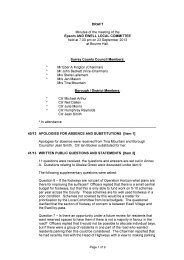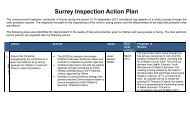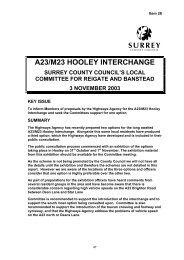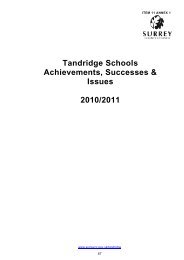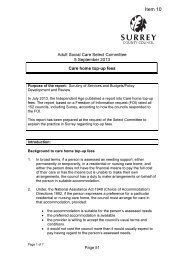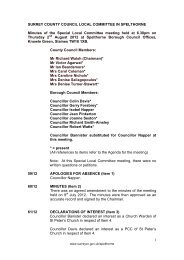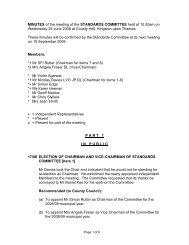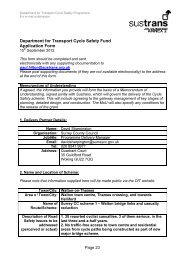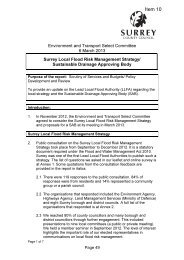[15 February 2013] PDF 66 KB - Surrey County Council
[15 February 2013] PDF 66 KB - Surrey County Council
[15 February 2013] PDF 66 KB - Surrey County Council
You also want an ePaper? Increase the reach of your titles
YUMPU automatically turns print PDFs into web optimized ePapers that Google loves.
Record of the Pension Fund Investment Advisers Group (IAG)9:45am <strong>15</strong> <strong>February</strong> <strong>2013</strong>, Offices of UBSItem 2Item 1PresentD Le Gal (Chair)J OrrickS Selleck (SS)T Elias (TE)D Josey (DJ)M FewS Little (SL)P TriggsJ EvansJ WilsonP Meredith (PM)J HarrisonRepresenting MercerSteve Turner (ST)Sanjay Mistry – Private debt training sessionRepresenting Fund ManagersSteve MagillDigby ArmstrongAlex BignallDJ DhananjaiMax JohnsonUBSCBRE1. Apologies for absence were received from David Wood and Nick Harrison.2. The Chair declared a personal interest to the IAG, due to her role as a TrusteeDirector of JP Morgan’s UK Pension Fund. Paul Meredith also declared an interestas a UBS pensioner.Item 1 – Notes of Meeting of 16 November 20123. After a couple of minor errors were pointed out, the minutes were noted.4. MF wanted to follow up on the issues currently facing CBRE. ST stated Mercerhave been reviewing the property portfolio and there are questions around theappropriateness of the multi-manager route. There have been problems with theEuropean investments and issues with highly geared funds. They have beenlooking at what could be done to ensure CBRE are a good fit with the rest of the<strong>Surrey</strong> fund.5. PM highlighted that when ING Real Estate were appointed in 2004, they wereamongst the best in class managers and initially performed well. The Europeaninvestments made in 2007 have proved disastrous and have been a drag onperformance ever since.Page 11
24. The quarterly performance of +3.3% was greater than the customised benchmarkof +2.9% (+0.4%).25. In absolute terms the best performing managers was Majedie, with a return of+7.3%, compared to a benchmark of +3.8% (+3.5%).26. In relative terms the best performing manager was also Majedie with theirourperformance of +3.5%.27. Newton underperformed with a return of +0.5% compared to a benchmark of+2.2% (-1.7%). CBRE and Mirabaud also slightly underperformed with a relativereturn of -0.3% and -0.2% respectively.28. The total Fund returned +12.4% over 12 months, which was above the benchmarkreturn of +10.7% (+1.7%)29. In absolute terms the best performing manager was Marathon with a return of+18.8% compared to benchmark return of +10.7% (+8.1%). In relative terms thebest performing manager was also Marathon with their outperformance of +8.1%.30. Marathon (+8.1%), UBS (+5.4%), Majedie (+3.9%) Newton (+3.5%) and Western(1.7%) all achieved their outperformance target for the year.31. CBRE (-0.3%) and Mirabaud (-0.4%) failed to beat the benchmark for the year.e) Public services pensions bill and proposed governance arrangements32. PT updated members on the current positions. The Bill is currently with the Houseof Lords and will receive its third reading on 26 <strong>February</strong> before going back to theCommons and, as things stand, is likely to receive Royal Assent in time for the<strong>2013</strong> valuation.33. Auto-Enrolment will be implemented by the <strong>County</strong> <strong>Council</strong> with effect from 1 April<strong>2013</strong>. This is where staff who are currently not members of the pension fund areauto-enrolled and have to opt out if they don’t want to remain a member. ThePensions Admin team at SCC is managing the process and estimate that 90% ofthose auto-enrolled will opt out again. However, early indications fromorganisations that have already implemented auto-enrolment show that it mightonly be around 75%.34. Members requested that an update is provided at the next meeting covering howthe process went and the number of opt outs.f) Actuarial Valuation35. The next valuation will be as at 31 March <strong>2013</strong>. A briefing note on the basis for theassumptions to be used such as discount rate and inflation is due to be released bythe actuary shortly. This is an important document as the assumptions used willhave a large role in determining the funding levels and therefore the contributionrates of each employer.36. The stabilisation policy will continue for the large, long-term employers such as thelocal authorities in the fund. This is where their contribution rates remain consistentover a number of valuation cycles in the expectation that the employers underpayin the bad times and overpay in the good. The contribution rates may have to bePage 44
Item 1adjusted as a result of the <strong>2013</strong> valuation if the results are outside of the acceptedparameters of the stabilisation policy, which is a distinct possibility this time round.Item 3 – Manager Meetings37. PT, PM and JE met with Marathon, Newton, Majedie, L&G and Mirabaud on 29January.38. Newton. The Group focused the discussion on Newton. Mercer rates Newtonhighly for their income and multi-asset return strategies, but only average forbenchmark strategies. The portfolio of stocks they have is relatively defensivewhich explains their recent underperformance.39. PM highlighted they did actually outperform +3% over the last 12 months, butagreed the December quarter had been relatively poor at -1.7%. The reason for theunderperformance in the quarter was due to being underweight in financials whichhad performed well. Over the long term Newton’s performance has suffered due tonot holding Apple, but this had actually increased performance over the quarter.40. Their investment themes and staff are generally good, but PM feels theorganisation does lack a bit of guts in decision making. They base decisions onsolid evidence which, whilst being a sound investment strategy, does mean theyoften miss real turnaround opportunities to drive performance.41. Over the last 5 years, they are 1% behind benchmark. Prior to that their record wasvery good. At the time Newton were appointed, the other managers who pitchedsuch as Alliance Bernstein have performed disastrously.42. Overall, WM say to not to make manager changes unless you are absolutelyconvinced and at the moment there is not a fundamental loss of confidenceamongst the board.43. JH stated that Newton have a very good reputation from absolute return strategiesbut in global equities they are somewhat lacking. It is not a bad place to havemoney and overall the insights that the organisation can provide should manifest inperformance.44. ST recommended that Newton should be asked what effect reducing the number ofstocks in the portfolio has had on performance compared to if they kept it thesame.Item 4 – Business Plan45. JE took the Group through the main tasks of the business plan and the activitiesthat the Pension Fund and Pension Admin teams will have to complete over thecoming <strong>2013</strong>/14 financial year.46. The plan is split into 6 main areas:• Administration• Communication• Actuarial/FundingPage 55
Item <strong>15</strong>7. There is a large polarisation in the performance of property in prime locationscompared to other property, for example, returns from Q2 2009 to Q3 2012 are+27% for prime shops and -9% for secondary/tertiary shops.58. CBRE predict that capital values will continue to decline in <strong>2013</strong> and will not start toincrease on an annual basis until 20<strong>15</strong>.59. The strategy CBRE will follow focus on the following core themes:• Long and secure income streams.• Acquiring core specialist fund at attractive discounts to NAV.• Prime shopping centres• Industrial property in SE England• Student housing in leading university townsOpportunistic Themes• Take advantage of bank distress- Acquisitions from bank driven disposals- Provision of mezzanine finance• Development finance in certain markets where demand is high• Mispriced high yield property60. CBRE intend to increase the portfolio allocation to debt to 10% which will beimplemented over the next two years. A new manager has been selected andCBRE are currently negotiating terms.61. Performance in the quarter was -0.3% and +0.7%, +5.3%, -5.9% & +2.1% in the 1year, 3 years, 5 years, & since inception respectively.62. The sector allocation compared to benchmark currently has the most overweightpositions as +17.4% to European property, +7.7% to other commercial which ismainly student accommodation. The most underweight are offices in the rest of theUK -9.4% and unit shops -6.7%.63. The largest contributors to performance over the last 12 months were the M&GSecured Property Income Fund (+0.8%) and West End of London Property UnitTrust (+0.7%). The largest detractors were UBS Triton Property Unit Trust (-0.7%)and CBRE Strategic Partners Europe Fund III (-0.6%).64. CBRE feel that the liquidation of the UBS Triton fund is the best way forward. It willmean that the sales period can be extended to three to five years and therefore itcan be done in a controlled manner which will maximise value. CBRE are willing totake a pragmatic view of the situation and, if another option is presented such as afund merger, they would encourage UBS to fully assess the potential of such aproposal.65. CBRE refused to be drawn into how much of the fund they own but admitted theywould be in the top two investors.<strong>66</strong>. DLG quizzed CBRE on how the fund can avoid perception that there needs to be afire sale of assets. CBRE think that the three to five year timeframe providesenough time to ensure there is competition for each asset and therefore realisticvalues are achieved.Page 77
67. Mercer previously initiated discussions with CBRE about changing their benchmarkfrom the current +1% IPD UK All Balanced Property Funds Index. CBRE agreedthat the +1% is at the top end of target performance. They believe they have theability to achieve it, but it does mean taking an increased level of risk.68. After CBRE had left, the Group discussed the potential change of the mandate.The Group felt that, whatever changes are made, the performance record needs toremain. The Group noted that making any changes to the property portfolio couldpotentially be expensive and take time.69. The Group agreed to ask CRBE to produce a report on the impact and changesthey would make if the target was reduced to +0.5% and how they would do it inthe most cost effective way. Mercer will present report at next meeting.70. The Group also briefly discussed making a direct allocation to a property incomefund outside of the CBRE remit. The fund is currently underweight in property andthis method could be used to bring the allocation up to the benchmark.71. UBS Digby Armstrong and Steve Magill attended the meeting to discuss the recentperformance of UBS. Over the quarter, they had outperformed +3.0% and over theyear +5.6%, 3 years +0.3%, 5 years +0.6% but underperformed -0.8% sinceinception.72. In the quarter, the largest contributors to performance were Lloyds +1.0% andDixons +0.9%. These firms were also the two largest contributors to performanceover the last year with +2.4% and +2.1% respectively. These are two of the stocksthat UBS have been saying for the last 18 months or so that they have a lot ofconviction in, so they were pleased that their assumptions have proved correct sofar.73. Lloyds Group shares are currently worth 52p and UBS have fair value as being70p. The stock current makes up 2% of the index and 7% of the portfolio. The bankis currently reducing costs by running down non-core services and is alsoimproving the balance sheet position. Questions remain about possible further baddebt write downs and potential fines for any role played in the LIBOR scandal.74. BP was highlighted as another key stock, current price is 453p and UBS thinks fairvalue is around 580p. The portfolio is currently 5% overweight in BP and it makesup 4% of the index. BP has lost $70bn market cap since the Macondo disaster (£2per share), with net costs of around $30bn (£1 per share). UBS expect the BPshare price to recover the lost £1 when the US Department of Justice settlementoccurs. UBS regards the resolution of the Russian investments as a positive stepand believe this hasn’t been reflected by the market yet.75. UBS highlighted that the value style of investing has generally performed poorlyover the last five years. The S&P Value Index is about 10% below the FTSE AllShare for the period. UBS now feel that market conditions are starting to improveand value investing performance will improve. A number of merger and acquisitionshave already taken place in early <strong>2013</strong> and they believe this is set to increasewhich will help drive performance.76. UBS aren’t reliant on the market to generate returns and instead focus onindividual companies rather than macro-economic factors. They do believe there isPage 88
Item 1more confidence being shown by investors in equities and the trend of increasingallocations to bonds rather than equities is starting to reverse.77. The outlook for <strong>2013</strong> is to keep the overweight positions in BP, Lloyds and Dixonsas UBS think there is still a lot of potential upside in these companies until theymeet fair value.78. UBS think performance over the last year has been good and feel that a number ofcompanies in the portfolio still look cheap which means there is a good chance thatpositive performance will continue. However, their overriding worry is findingenough cheap companies to fill the portfolio.Item 7 – Member Training – Private Debt79. Sanjay Mistry from the Alternatives Boutiques team at Mercer attended the meetingto give members a training session on private debt.80. Private debt refers to an investment in privately negotiated debt. It can involveinvesting in senior bank debt, leveraged loans, mezzanine and subordinated debtwithin the capital structures of corporate entities.81. In 1999 banks made up 88% of the loan market but the financial crisis has led to alarge reduction in bank lending. In 2012 only 51% of the loan market was made bybanks and this has created a number of opportunities for institutional investors.82. Private debt is a broad term which covers a number of different products withdifferent risk/return profiles. Property and infrastructure senior debt is seen as lowrisk with returns of between 3 - 5%, right up to corporate mezzanine debt withreturns of 12 -<strong>15</strong>%.83. Private debt has similar characteristics to private equity in terms of cash flows.Funds often have limited fund raising periods and commitments are drawn downover 2 - 5 years. The J-curve is less pronounced than for private equityinvestments.84. Each deal has a negatively skewed risk/return profile in that the upside is largelycapped, but downside is not. To mitigate this, investors need to invest in welldiversified funds.85. Management fees are high at around 1 to 2% pa and 10 – 20% performance fees(with a 6 – 8% hurdle) are the norm.Additional Item – Treasury Strategy86. Members were informed that the county council had approved its treasury strategyfor <strong>2013</strong>/14. Members agreed that the fund’s treasury strategy should again mirrorthe county council for <strong>2013</strong>/14.Meeting concluded 3:30pmPage 99
This page is intentionally left blankPage 10


![[15 February 2013] PDF 66 KB - Surrey County Council](https://img.yumpu.com/51850903/1/500x640/15-february-2013-pdf-66-kb-surrey-county-council.jpg)
